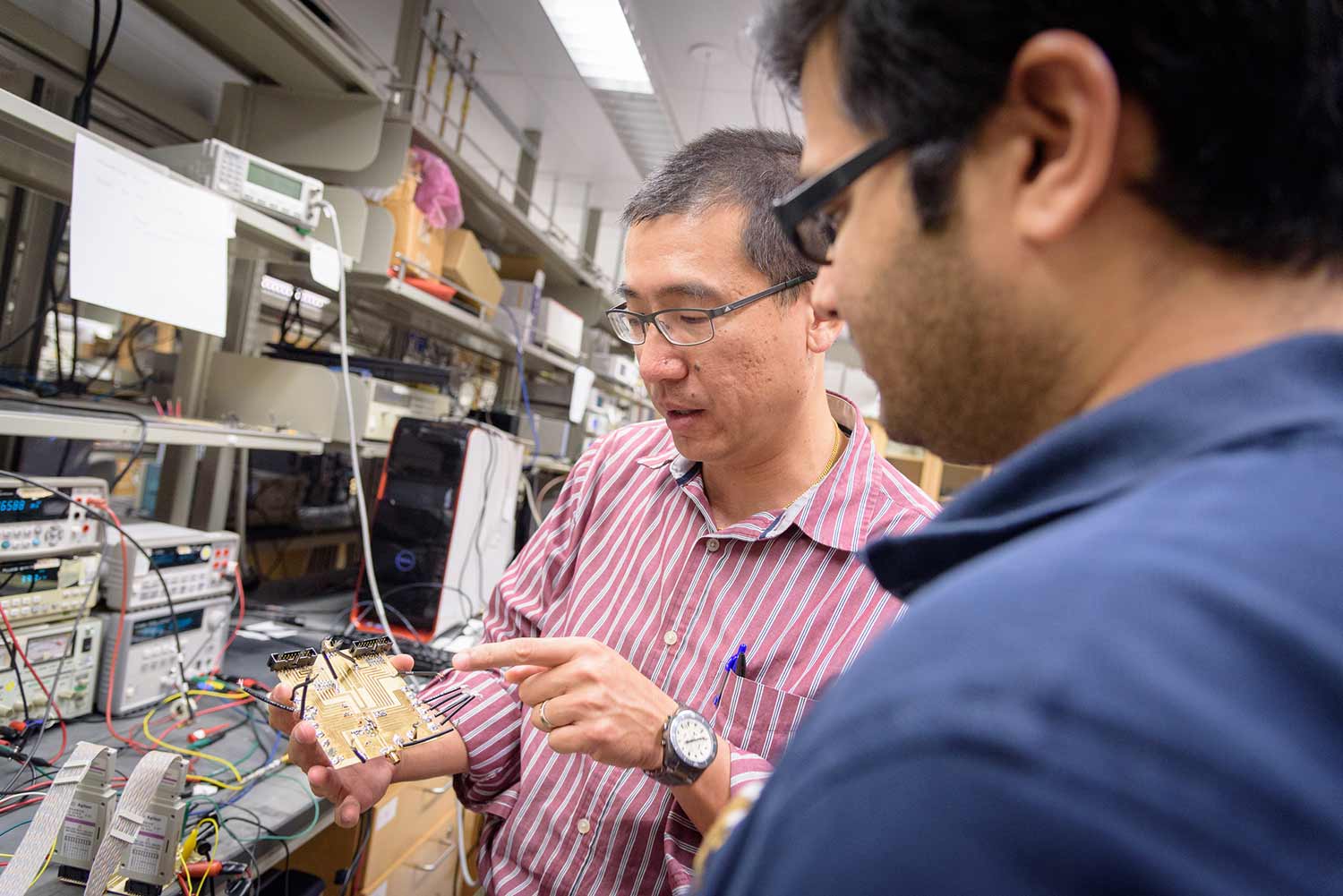Scientists Discover a New Signaling Pathway and Design a Novel Drug for Liver Fibrosis
Health & Behavior

Vincent Leung (left), the new technical director of the QI Circuits Labs, discusses a CMOS/ GaN broadband digitally-controlled power amplifier with Prof. Peter Asback's graduate student, Varish Diddi. Photo by Alex Matthews for QI.
When Vincent (Wingching) Leung was a Ph.D. student at the University of California, San Diego, the campus laboratory where he now serves as technical director was nothing but a wide swath of empty grass playing fields.
Now the Qualcomm Institute Circuits Labs, which are housed at UC San Diego’s Atkinson Hall, are home to a comprehensive suite of components and software for designing, assembling and testing new wireless devices for 4G/5G (fourth and fifth generation) communication systems -- including state-of-the-art equipment rarely found in a university environment.
After graduating from UC San Diego in 2004 with a doctorate in electrical and computer engineering, Leung worked everywhere from small design offices to headquarters of large research laboratories, but he managed to consistently keep one foot in academia – something he says “is always dear to my heart.” At Columbia University he taught a graduate level course in advanced analog integrated circuits (IC), and while working for eight years at Qualcomm in the cellular radio frequency integrated circuit group (where he had a lead position designing the transceivers found in most cell phones), Leung maintained a working relationship with the QI Circuits Labs as a collaborator with several UC San Diego professors, including Larry Larson and Peter Asbeck.
It’s this combination of industry and academic experience that positions Leung as an ideal candidate to take the helm at the Circuits Labs – although he acknowledges that this is “not a conventional career path.”
“It is not easy to leave a very rewarding job in a hugely successful company like Qualcomm, but I feel I must answer my inner call to work on ‘fun, futuristic’ circuit research and applications,” he says. “My previous jobs have molded me into the engineer/ researcher I am today. I am eager to apply my skills in QI’s unique multidisciplinary, entrepreneurial environment.”
The work being done in the Circuits Labs primarily focuses on addressing one of the biggest challenges for 5G wireless networks: supporting fast upload and download speeds on an increasingly crowded electromagnetic spectrum, and ultimately creating untapped territory for commercial applications, particularly on what’s known as mm-wave frequencies. To facilitate this work, the labs boast signal generation and spectrum/ network analysis capabilities up to the 100 GHz range. They house multiple probing stations for IC testing and a screen room for high sensitivity measurement.
Since their establishment, the Circuits Labs have always been at the forefront of RF/ millimeter-wave circuit research, and they are widely recognized as the world-leader in power amplifier design. Under the leadership of ECE faculty, researchers in the labs pioneered ground-breaking techniques in the field, such as envelope tracking, digital pre-distortion and all-digital switching-mode topologies.
“The Circuits Labs have a long and glorious history of research and development for enabling today’s cellular communications, particularly in the area of power amplifiers,” notes Leung. “The work conducted here continues to push the boundaries of amplifier efficiency, linearity and bandwidth. What I hope to bring to the lab are system-level transceivers design know-how. There are a lot of challenges in 5G communications, and I desire to make a difference.”
Leung says he is very passionate about teaching and providing researchers with relevant RFIC instruction as technical director of the labs.
“I look forward to giving a graduate class on RFIC in the near future,” adds Leung. “Having worked in the industry on real products, I developed a sense of how to present knowledge in a way that is relevant to working professionals while meeting rigorous academic standards.”
Leung cites, for example, "NF" and "IIP2/3," as common specifications of RF circuit performances. They describe how well a circuit can detect very tiny signals in a sea of very strong jammers (which prevent cellular phones from receiving signals from base stations).
“To untrained eyes,” he says, “these are just numbers on paper with rather simple mathematical equations. It may not be obvious why they matter so much. I would like to frame the discussion in real-world scenarios (like the cell phone in your hand), and demonstrate how tough the situation is. This will make the textbook fundamentals ‘come alive.’ I also like to walk the class through state-of-the-art commercial products and research publication. Hopefully, it helps to illustrate the creativity process: identifying the problem, and overcoming it in an cost-effective, intelligent manner.”
Leung notes that part of the vision for the labs “is to bring up the labs to serve the circuit research needs on campus, and even extend its reach to local startups and our industrial partners.
"Money can buy test equipment,” he adds, “but it is the combination of our researchers’ creativity and techniques, that make it so powerful. The best is yet to come.”
Keep up with all the latest from UC San Diego. Subscribe to the newsletter today.